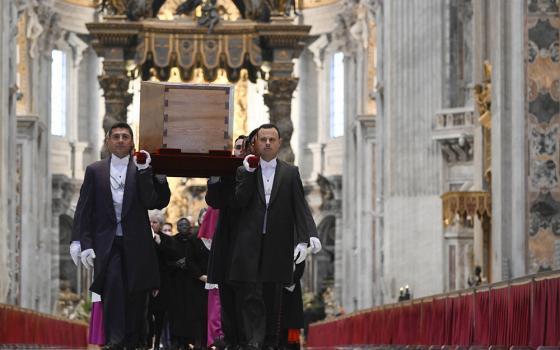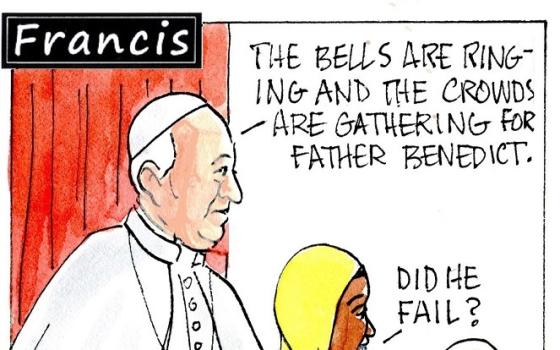Pope Benedict XVI and his brother, Msgr. Georg Ratzinger, walk through the garden of a house the pope owns in Pentling, near Regensburg, Germany, Sept. 13, 2006. Pope Benedict died Dec. 31, 2022, at the age of 95 in his residence at the Vatican. (CNS/Reuters/Michaela Rehle)
Before Pope Francis, Pope Benedict was called "the Green Pope." This may be mostly due to how he moved the needle forward in recognizing environmental issues as part of the church's moral teaching, but for me, Benedict's greenest legacy has liturgical roots.
During Benedict's tenure, the Vatican declared pollution among the "social sins" of the world and in 2008 installed 2,700 solar panels on the roof of the Paul VI auditorium. The late pope's World Day of Peace address on January 1, 2010, could have been written on a placard at a climate emergency rally: "If You Want to Cultivate Peace, Protect Creation."
This image of Benedict as an advocate for ecological justice may be difficult for some of us to wrap our heads around, given many of his "traditional" concerns, such as the integrity of the liturgy. Yet Benedict's concern for the liturgy and his concern for the earth flowed from the same source: God's creative work and our response to it.
How creation works and how God acts through it is a crucial lens for how we worship, something Benedict emphasized repeatedly in The Spirit of the Liturgy. The idea that how we worship should match how we treat the earth drove his environmental work.
Benedict's most straightforward point is that liturgies traditionally face to the east — often referred to as ad orientem (though this term is today most commonly heard in the context of the Latin Mass/Novus Ordo debate: whether the priest should face the tabernacle/crucifix or the people, versus populum). Facing toward the east during liturgy is a nature-based shift that the early church made in its Jewish inheritance.
Along with the Temple in Jerusalem, the synagogue was the most important source for the traditional church building. The synagogue faced the direction of Jerusalem, so the congregation could pray facing the Temple. Christianity maintained a directional orientation but changed the focus to the rising sun, which symbolized the resurrection and is sometimes thought to be the direction from where Christ will return.
'Creation, history, and worship are in a relationship of reciprocity.'
—Pope Benedict XVI
"Praying toward the east means going to meet the coming Christ" and "goes back to the earliest times and was always regarded as an essential characteristic of Christian liturgy (and indeed of private prayer)," Benedict said. "The cosmic symbol of the rising sun expresses the universality of God above all particular places and yet maintains the concreteness of divine revelation. Our praying is thus inserted into the procession of the nations to God" and affects entry into “the New Heaven and the New Earth," he continued.
As a student of Indigenous traditions, I've seen how many ceremonies and cultural practices are structured around praying east. In the Navajo context, doors of hogans (traditional dwellings) face east to receive rays of the rising sun. Morning prayers must be said facing them.
Servant of God Nicholas Black Elk explains in The Sacred Pipe why this is also true in a Lakota context, saying, "The sweat lodge is always constructed with its door to the east, for it is from this direction that the light of wisdom comes."
Jesuit Fr. Tony Lusvardi, who teaches sacramental theology at the Pontifical Gregorian University in Rome, taught on the Rosebud Reservation in South Dakota 2011–14 and spends his summers working at St. Isaac Jogues, the Lakota parish in Rapid City, South Dakota, said he has "noticed certain resonances between Lakota spirituality and a more traditional form of worship." He recounted one of his favorite moments on Rosebud: "I was substitute teaching for a third-grade class; when I began with a prayer, the third graders asked me, 'Can we pray facing east?' I thought, 'You're the most adorable little Ratzingerians I've ever met!' "
We could just as easily say Benedict is adorably Lakotan. Indigenous ceremony and ceremonial space are cosmic in scope. "We are really making the universe in a likeness," Black Elk wrote in The Sacred Pipe, describing the Sun Dance arbor, which is also open to the east.
Benedict highlights the commonality between the cosmic scope of Indigenous traditions — what he calls "nature religions" — and Christian liturgy. The entire universe is the setting for and a participant in God's covenant, which the liturgy enacts. In this he favorably draws on the work of the late Jesuit Fr. Pierre Teilhard de Chardin and affirms that "the goal of worship and the goal of creation as a whole are one and the same — divinization, a world of freedom and love," of "God all in all (1 Corinthians 15:28)."
Often details and rubrics seem to lose the forest for the trees. But being around Indigenous ceremony helped me to grow into Benedict's holism, what he hoped to recover in our fractured context and what Black Elk said in describing the ritual minutiae of the Sun Dance: "There is a significance for everything."
Done rightly, liturgy says we are not the only agents that matter in a deistic clock but part of a spiritually alive universe. For Benedict, facing the east will help recover "praying with all of creation," a theme echoed in Black Elk's Thanksgiving prayer: "The nations of living things the world over — and we the two-leggeds, along with the children and smaller ones with them — come to you today to express thanks."
A banner showing St. Kateri Tekakwitha hangs from the facade of St. Peter's Basilica as Pope Benedict XVI celebrates the canonization Mass for seven new saints in St. Peter's Square at the Vatican Oct. 21. St. Kateri, the first Indigenous North American to be canonized, is patron of ecology. (CNS/Paul Haring)
If you pray with all of creation, it changes your relationship with it from one of possession to one of kinship, from sustainability to right relationship. Francis fleshes this out more fully in his encyclical "Laudato Si', on Care for Our Common Home," but it's there in Benedict's theology, too. "It is imperative that mankind renew and strengthen 'that covenant between human beings and the environment, which should mirror the creative love of God, from whom we come and towards whom we are journeying,' " Benedict said in his 2010 World Day of Peace message.
Indigenous author Robin Wall Kimmerer in her book Braiding Sweetgrass says that Indigenous ceremony does multifaceted work: unites people in a common vision, forges spiritual connection to land and fosters the integrity of the ecosystem. She asks non-Indigenous peoples how, through ceremony, "Can we extend our bonds of celebration and support from our own species to the others who need us?"
I think Benedict did, in a nascent yet real way, even using the same language of reciprocity and healing that Kimmerer often uses. "Creation, history, and worship are in a relationship of reciprocity," Benedict wrote, saying also that worship "not only saves mankind but is also meant to draw the whole of reality into communion with God," and liturgy contains within it an "aspect of healing, the loving transformation of broken freedom, of painful expiation."
Given more time, I think Benedict would have more explicitly connected these logical and beautifully integral theological dots, primarily because of his view of the liturgy. Now it’s up to us to honor his legacy and cultivate this work, allowing our liturgies to become the healing ceremonies of reciprocity between God and all beings that Benedict envisioned.
Presiding at the 2012 canonization Mass for St. Kateri Tekakwitha, patron of ecology and the first Indigenous North American saint, Benedict said, "In her, faith and culture enrich each other!" Reflecting on the life of Benedict, I would say that in him, the liturgy and creation enrich each other.
We send up our prayers that God welcomes Benedict home. And after a lifetime of praying together, I think all creation does, too.






